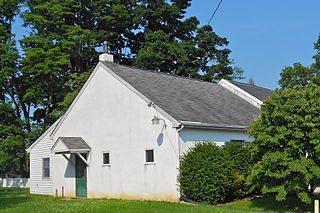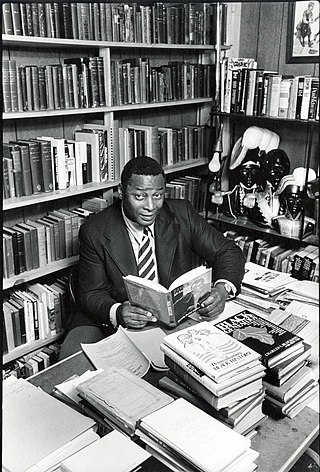The African Union Methodist Protestant Church (AUMPC), abbreviated as A.U.M.P. Church, is a Methodist denomination. It was chartered by Peter Spencer (1782–1843) in Wilmington, Delaware, in 1813 as the "Union Church of Africans", where it became known as the "African Union Church".

William Still was an African-American abolitionist based in Philadelphia, Pennsylvania. He was a conductor of the Underground Railroad and was responsible for aiding and assisting at least 649 slaves to freedom towards North. Still was also a businessman, writer, historian and civil rights activist. Before the American Civil War, Still was chairman of the Vigilance Committee of the Pennsylvania Anti-Slavery Society, named the Vigilant Association of Philadelphia. He directly aided fugitive slaves and also kept records of the people served in order to help families reunite.

Ercildoun, population about 100, is an unincorporated community in East Fallowfield Township, Chester County, Pennsylvania, United States. The hamlet was founded by Quakers and was an early center of the abolitionist movement. In 1985 the entire hamlet, including 31 properties, was listed as a historic district on the National Register of Historic Places. Of these properties two were vacant land, 14 were significant buildings, ten were contributing buildings, and five buildings, built in the 1950s, were non-contributing. The Lukens Pierce House, an octagon house listed separately on the U.S. National Register of Historic Places, is located about half a mile northwest of the hamlet. Ercildoun is one of about ten hamlets in the township, which has no cities or towns, but has 31 sites listed on the National Register. It is one of the larger hamlets, located near the center of the township, and historically among the best known. The city of Coatesville is about 3 miles north.

St. David's Episcopal Church, also known as St. David's at Radnor or Old St. David's, is a parish of the Episcopal Church located at 763 South Valley Forge Road in Radnor Township, Pennsylvania. The church property contains the original church built in 1715, a chapel, church offices, school and cemetery. The property straddles the borders of Radnor Township and Newtown Township in Delaware County and the majority of the cemetery is in Easttown Township, Chester County. It was founded c. 1700 in the Welsh Tract section of the Province of Pennsylvania by Welsh settlers and has grown to be the largest congregation in the Episcopal Diocese of Pennsylvania with approximately 3,000 members. The original church and cemetery were placed on the National Register of Historic Places in 1978.

Bethel AME Church, now known as the Central Pennsylvania African American Museum, is a historic African Methodist Episcopal church at 119 North 10th Street in Reading, Berks County, Pennsylvania. It was originally built in 1837, and is a 2½-storey brick and stucco building with a gable roof. It was rebuilt about 1867–1869, and remodeled in 1889. It features a three-storey brick tower with a pyramidal roof topped by a finial. The church is known to have housed fugitive slaves and the congregation was active in the Underground Railroad. The church is now home to a museum dedicated to the history of African Americans in Central Pennsylvania.

Bethel African Methodist Episcopal Church is a historic African Methodist Episcopal Church in Springtown, New Jersey, United States. The church was part of two free negro communities, Othello and Springtown, established by local Quaker families, like the Van Leer Family. The congregation was established in 1810 in Greenwich Township as the African Methodist Society and joined the African Methodist Episcopal Church in 1817. A previous church building was burned down in the 1830s in an arson incident and the current structure was built between 1838 and 1841.

Mount Zion African Methodist Episcopal Church and Mount Zion Cemetery is a historic church and cemetery located at 172 Garwin Road in Woolwich Township, New Jersey, United States. The church was a stop on the Greenwich Line of the Underground Railroad through South Jersey operated by Harriet Tubman for 10 years. The church provided supplies and shelter to runaway slaves on their way to Canada from the South. The church and cemetery were part of the early 19th-century free negro settlement sponsored by Quakers known as Small Gloucester.

David Bustill Bowser was a 19th-century African-American ornamental artist, portraitist, and social activist. He designed battle flags for eleven African-American regiments during the American Civil War and painted portraits of prominent Americans, including U.S. President Abraham Lincoln and abolitionist John Brown. Politically active throughout much of his adult life, he was a contributor to the Undergrounds Railroad and also helped to secure the post-war passage of key civil rights legislation in Pennsylvania.

The Hovenden House, Barn and Abolition Hall is a group of historic buildings which are located in Plymouth Meeting, Whitemarsh Township, Montgomery County, Pennsylvania. In the decades prior to the American Civil War, this property served as an important station on the Underground Railroad. Abolition Hall was built to be a meeting place for abolitionists, and later was the studio of artist Thomas Hovenden.

Marshalltown is an unincorporated community located within Mannington Township, in Salem County, New Jersey. It has also been known as Frogtown.
Hinsonville is a former municipality in Chester County, Pennsylvania which is now largely replaced by the grounds of Lincoln University. It was established and mostly populated by free African American residents, with the acres of Hinsonville being first purchased by Edward Walls, a free black man who was born in Maryland, in 1793. The town was named for its first permanent resident, Emory Hinson, another Maryland-born free black man. Located six miles north of the Mason–Dixon line and at the crossroads of Russellville-Elkdale Road and Oxford-Jennersville Road in the southern tip of Upper Oxford Township, the agricultural community of Hinsonville became an ideal residence for African Americans escaping slavery in neighboring Maryland from the 1820s to the 1850s. By 1843–1845, when the Hosanna Meeting House was established in town, Hinsonville had expanded considerably due to the flight of free black families from the South.

Charles Leroy Blockson was an American historian, author, bibliophile, and collector of books, historical documents, art, and other materials related to the history and culture of African Americans, continental Africans, and the African diaspora throughout the rest of the world. He curated two university collections related to the study of African-American history and culture: the Charles L. Blockson Collection of African-Americana and the African Diaspora at Pennsylvania State University and the Charles L. Blockson Afro-American Collection at Temple University.
Lincoln Cemetery was founded in November 1877 by the Wesley Union African Methodist Episcopal Zion Church, and is located at 201 South 30th Street in the Susquehanna Township area of Harrisburg, Pennsylvania.
Indian Run is a populated place in Wilmington Township of Mercer County, Pennsylvania, named for the stream Indian Run. Indian Run had a reputation as a "safe haven" for African Americans, whether they were free or escaping slavery. White Chapel Church was established by abolitionists who broke away from a church in New Wilmington. In the 1840s, a settlement was created for freedmen called Pandenarium. John Young and others were prominent Underground Railroad conductors.

The Christian Street Historic District is an historic district located along Christian Street in Philadelphia, Pennsylvania, United States. It is also known as Black Doctors' Row. The narrow district extends approximately six city blocks, from the 1400 block of Christian Street to the intersection of Christian Street with 20th Street. Its width is one block on either side of Christian Street, extending to Montrose Street and Webster Street. It is within the area known as South Philadelphia and the neighborhood known as Graduate Hospital.

Mount Zion A.M.E. Church is a historic African American church in Tredyffrin Township, Chester County, Pennsylvania. Built in 1880 and expanded in 1906, Mount Zion was listed on the National Register of Historic Places on January 27, 2015. It was an important community gathering place for African Americans battling racial segregation of local schools in the 1930s.

Isaac Mendenhall was an American farmer, abolitionist, and station master on the Underground Railroad in Chester County, Pennsylvania. Isaac and Dinah Mendenhall aided several hundred fugitives to escape to freedom. Prosperous farmers, they lived at the estate of Oakdale, listed on the National Register of Historic Places since 1972. A Pennsylvania state historical marker was dedicated in their honor on November 10, 2018.














